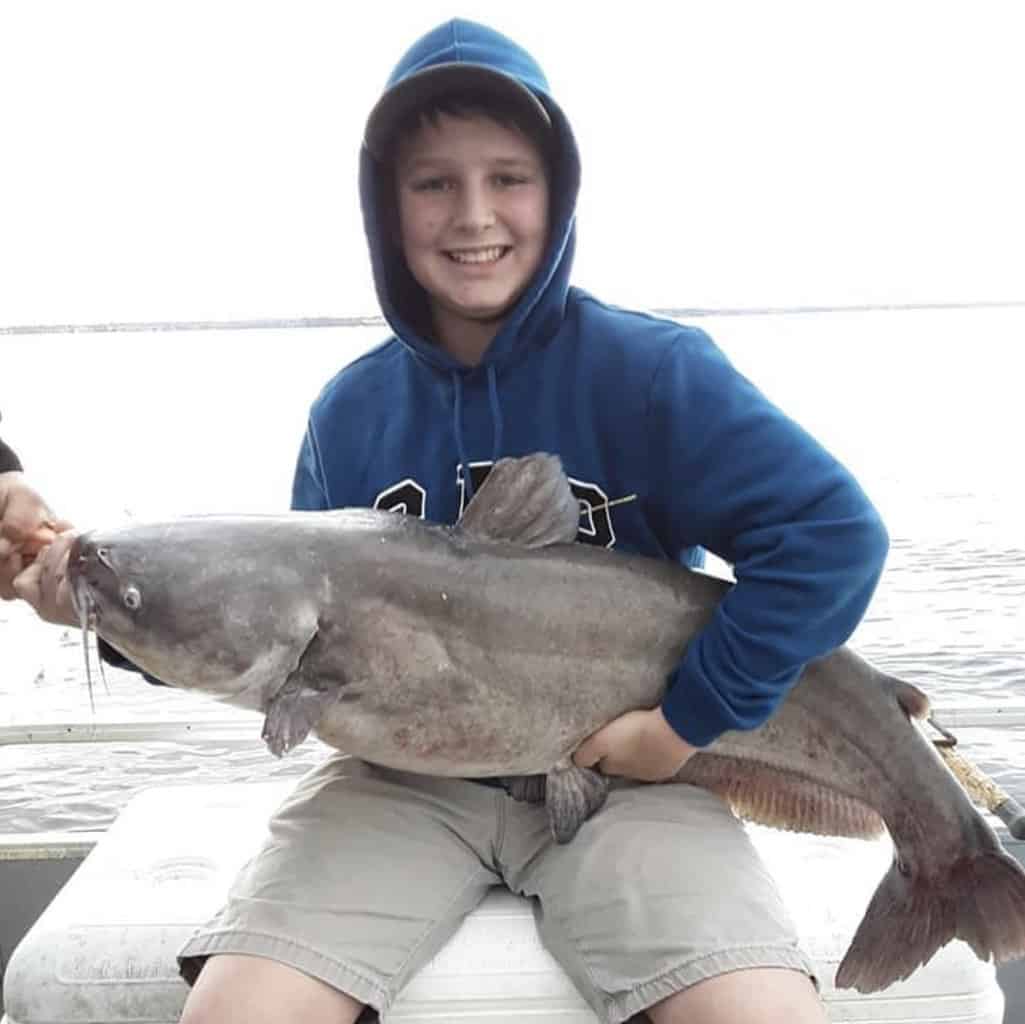Consistently ranked among the best fishing lakes in Texas, Lake Conroe is a sprawling reservoir in the East Texas Pineywoods region.
Lake Conroe spans about 22,000 acres at full pool and offers 157 miles of shoreline. Just an hour from Houston on the West Fork of the San Jacinto River, it’s easily one of the most popular lakes in this part of the state.
Outstanding fishing is available for largemouth bass, black and white crappie, channel and blue catfish, and a handful of other species. There are truly year-round fishing opportunities here.
Part of what makes Lake Conroe unique is its diversity of habitat. The highly developed lower lake has abundant marinas, floating docks and bulkheads. Top-notch deep structure and shallow artificial cover make up for sparse vegetation.
The upper end of the lake, most of it surrounded by undeveloped national forest land, is markedly different. In addition to shallow coves filled with brush, reeds and hydrilla, this section includes forests of submerged timber that were left standing when the lake was built in 1973.
Whether you’re an angler who enjoys plumbing the depths or pulling fish from near-shore cover, Lake Conroe is a lake that can challenge anglers but offers great rewards in return.
Largemouth Bass Fishing
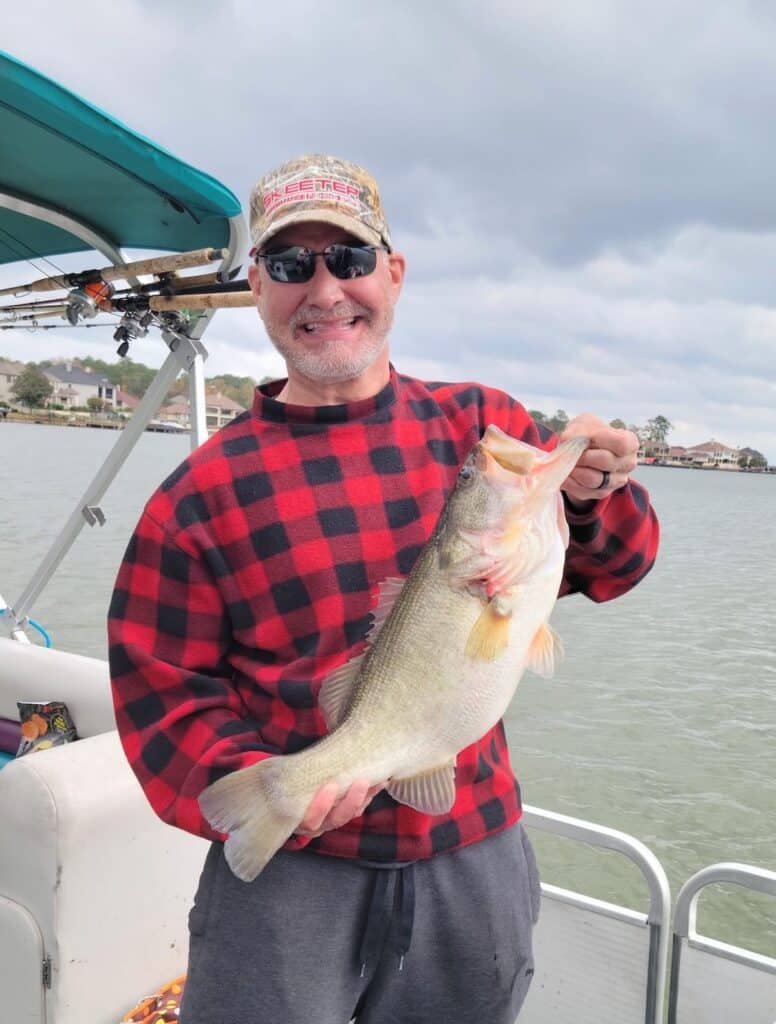
Lake Conroe is rightly regarded as one of the best bass lakes in Texas, and is arguably the top bass fishery in the Houston area. Hulking Florida strain largemouth bass have been stocked here for decades.
Bass over 5 pounds are fairly common in Lake Conroe, and there’s always a fair shot at a trophy. The lake record weighs just shy of 16 pounds, and several 10-pounders are pulled out of the lake every year.
Lake Conroe offers an impressive diversity of habitats, and anglers have many options. The docks, boat houses and bulkheads that dominate the lower lake provide great shallow bass action, and prominent main lake points and steep drop-offs can also be productive.
The lake’s shallower, timber-filled upper end also offers prime bass cover. Like a lot of large Texas reservoirs, Lake Conroe is fairly clear at its lower end toward the dam, and quite turbid in its upper reaches.
Bass are caught in every season here.
In January and February, try flipping soft plastics or running a Rat-L-Trap around shoreline docks and trees between 10 and 20 feet deep. Pre-spawn patterns usually start to take shape in late February.
March is a great month to fish for bass on Lake Conroe, as many largemouths begin to spawn while others are still in pre-spawn mode. Backs of coves and creeks are key areas this time of year.
Some of the best areas for spring bass include Caney, Atkins and Lewis Creeks, Lochness Cove, Lake Paula, and the Walden area.
Bass are usually on their beds into April, and there’s excellent shallow fishing with creature baits and wacky worms.
Dead-sticking soft plastics around docks and bulkheads is a great tactic throughout post-spawn and into June. Most bass head deeper in summer, but shallow patterns resume in fall.
The best docks and bulkheads are the ones that reach farthest out toward deep water.
Brush piles are also productive in the fall. Crappie anglers have sunk many of these structures near creeks, points, humps, and old road beds throughout the lake, but they’re also bass magnets.
Use polarized glasses to spot the buoys just below the surface that mark the brush piles.
Some fish habitat structures have also been placed in the lake by Texas Parks & Wildlife, and you will find their locations on TPWD’s online Fish Habitat Structure Viewer.
Catch More Bass
Find all of the best bass lakes in Texas in our statewide rundown plus a full account of all the best bass lakes close to Houston.
Pick up bass fishing techniques or tips in our simple how-to guide.
Crappie Fishing
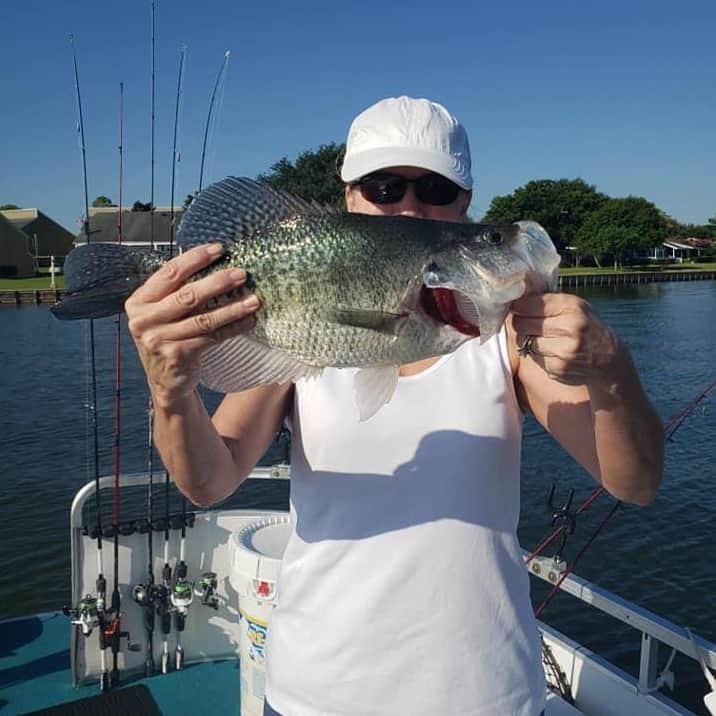
Lake Conroe has long been considered one of Texas’ best crappie lakes. And while populations can be cyclical—crappies may not spawn successfully during drought years—the fishing in Conroe usually oscillates only between “good” and “great”.
Black crappie and white crappie are both abundant in Lake Conroe, with lots of 10- to 12-inch fish along with occasional slabs that top 2 pounds. Crappies move with the seasons, but the key to finding them is almost always locating productive brush piles.
That, of course, is easier said than done. Local anglers have sunk hundreds, maybe thousands, of brush piles all over Lake Conroe. Finding the perfect brush at any given time is a matter of looking at the right depth near the right bottom structure.
It helps to have a sonar unit of some kind. Anglers submerged many of the best brush piles along channel swings, humps, and main lake points and near deep boat docks and bridge pilings.
With the exception of the spawning season (roughly February through March), the most productive brush piles are usually in 16 to 24 feet of water. It’s usually a good idea to start relatively shallow and work your way deeper.
Spider rigging is a sound search tactic. It involves trolling at a snail’s pace, with as many as six or eight rods at various depths, each baited with jigs in a range of sizes and colors.
If you’re unfamiliar with the lake, the 1097 bridge crossing is a great place to start. The bridge spans the lake from east to west. Crappies commonly hang out around the bridge pilings and nearby brush piles, moving higher and lower in the water column depending on the season.
Dropping a minnow beneath a slip bobber is a great way to fish at a precise depth. Jigs work well too, but minnows almost always get more strikes. Hook minnows behind the dorsal fin, but be careful not to hit the spine.
In late winter, when crappies spawn in just a few feet of water, they are easily caught using minnows and jigs in near-shore cover. Look for them around the abundant stumps, brush, timber and vegetation in the Caney Creek Arm and throughout the upper end of the lake.
Catch More Crappie
Find the best crappie fishing spots across Texas.
Then check out the best ways to catch them with our complete guide to crappie fishing.
Catfish Fishing
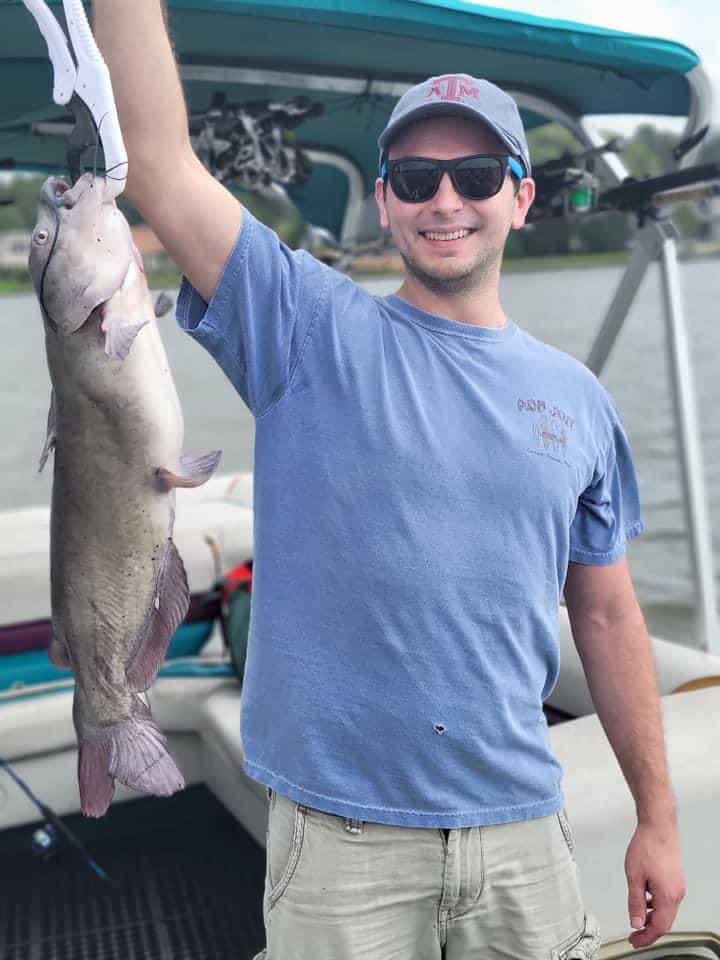
Easily one of the best catfish lakes in the Houston area, Lake Conroe supports a tremendous population of channel catfish that commonly exceed 10 pounds. On a good day, the bite can be nonstop.
Blue catfish are also present, and although they are less common, they can also reach much bigger sizes, as the 67-pound lake record will attest. Anglers occasionally land giant flatheads as well.
The best catfish bite tends to be during the warmer months, but good catches of channel cats are taken from Lake Conroe year-round. Trot lining is effective, particularly in the backs of coves and the upper end of the lake, but rod-and-reel anglers often do just as well.
The most consistent fishing is around baited holes—brush piles or other cover that local anglers routinely bait with soured grain or range cubes. The ideal spots much of the year are brush piles 18 to 25 feet deep along creek channels, roadbeds, and other deep main lake structure.
During summer, shallower holes are often better. Channel catfish in Lake Conroe are most concentrated from June through early July, when they congregate around shallow cover to spawn, sometimes in as little as 5 feet of water. Many are caught right up against bulkheads.
The 1097 bridge is a very popular area to target catfish, especially around the rip-rap at either end of the bridge. Many anglers also fish under the power lines that cross the Atkins Creek/Stewart Creek arm and the Little Lake Creek arm.
Anglers catch some catfish in broad daylight, but the best shallow fishing usually takes place at night. Shore-bound anglers should fish for catfish after dusk when fish leave cover to prowl shallow flats.
Drifting over flats is also productive at night. Cut shad are one of the best catfish baits here, though a wide range of other natural offerings can be effective. Shrimp, chicken livers and dough baits all have their devotees.
Catch More Catfish
What other lakes are great for catfish? Check out Best Catfish Fishing Lakes and Rivers Near Houston. Want to head farther afield? See Best Catfish Fishing Lakes in Texas.
New to catfishing or want to learn some new tactics? Read our simple guide to catfish fishing techniques and tips (including top baits).
Other Fish Species
Hybrid Striped Bass
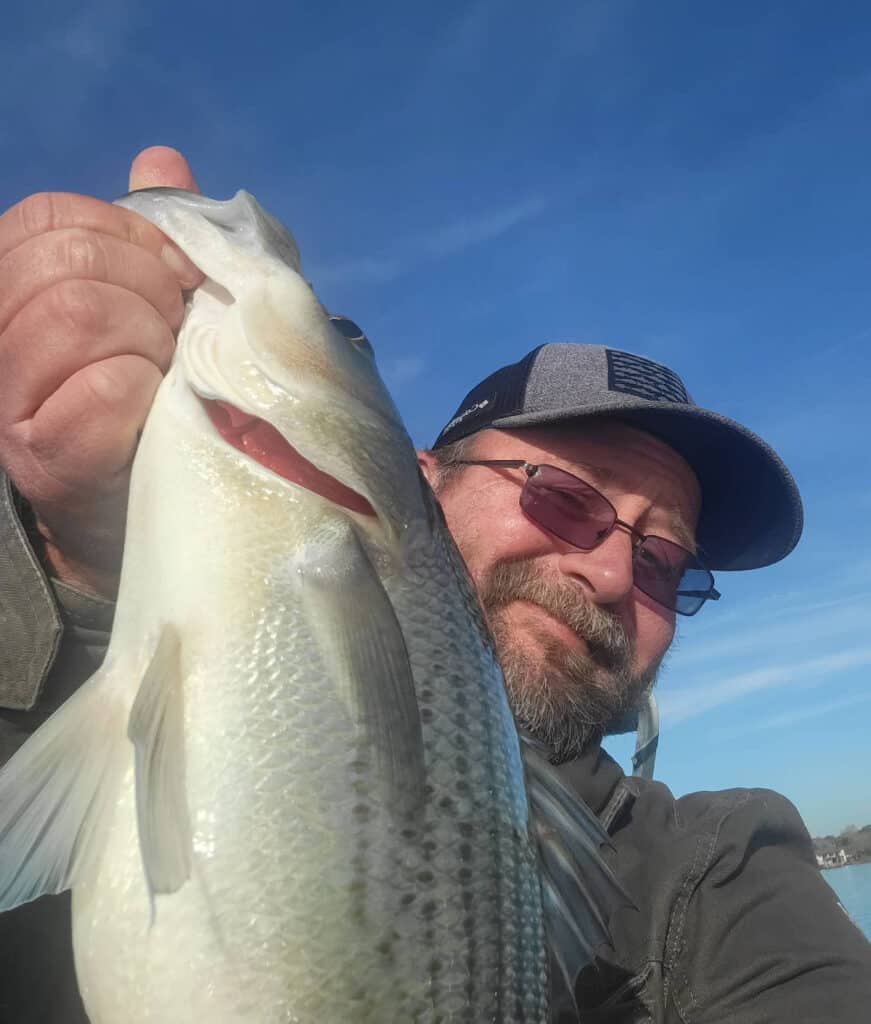
Texas Parks & Wildlife has been stocking hybrid striped bass in Lake Conroe since 1995, and although these hatchery-raised blends of striped bass and white bass have thrived here, they continue to be relatively unpressured.
Perhaps they go under most anglers’ radar because they favor deep, open waters. But hybrid stripers often reach 10 pounds and are known as ferocious fighters, making them a great and largely untapped resource.
Throughout most of the year, hybrids school up in lower Lake Conroe, chasing schools of shad along the river channel and over deep humps and road beds. The areas around the entrances to the Little Lake Creek and Atkins Creek arms are some of their most reliable haunts.
Most anglers catch them by trolling live shad or shad-imitating crankbaits. Fishing vertically with jigging spoons or live shad is also effective once you pinpoint the hybrids, but trolling is the go-to search method. Hellbender Spoons are popular for both trolling and jigging.
From late fall through early spring, hybrid stripers are mostly caught at depths of 20 to 35 feet near deep structure in the main lake. At times, they will feed on shad at the surface, and it may be possible to spot the resulting activity.
Lake Conroe also has a modest population of white bass, which are smaller than the hybrids on average, but behave in similar ways. A lot of white bass are caught on spoons, curlytail grubs and Rat-L-Traps.
Both species push into shallow water in March and April, heading toward creek arms and into the upper end of the lake on a spawning run. Hybrids cannot reproduce, but instinct still drives them to follow white bass upstream this time of year.
Bluegill & Sunfish
Bluegill are among the most common fish in Lake Conroe, and they reach impressive sizes here. Eight- to 10-inch bluegill are abundant, and individuals that measure 12 inches are not outside the realm of possibility.
Longear sunfish and redear sunfish are also quite common, and the latter get just as big as bluegill. Fishing is best during the spring and summer months in the creek arms and coves, as well as the upper end of Lake Conroe.
Fish with a live redworm around weeds, brush, stumps, rocks and timber. At times, fishing with a cork or float can be a great way to keep your bait in the strike zone.
But you may also want to attach a split shot or two and eliminate the bobber to get your offering down faster. Smaller bluegill tend to be in shallow water, but the bigger ones are often just a bit deeper.
Baker Bridge, which carries Route 1375 across the upper end of Lake Conroe, is an excellent spot for bluegill. Fish along the drop-offs to the river channel below and around the bridge.
Casting around floating boat docks at marinas is also a great way to fill a pail with bluegill.
In addition, because they often inhabit quiet blackwaters close to shore, bluegill and sunfish provide prime opportunities for kayak anglers.
Catch More Bluegill and Sunfish
While these panfish are common across Texas, some places are better and have bigger fish than others. That’s why we’ve carefully curated a manageable list for you with the best bluegill and sunfish fishing lakes in Texas.
Also, while this type of fishing is a joy in part because of its simplicity, we have an easy fishing guide that will help you catch more bluegill and other sunfish with different types of techniques, from bait fishing to casting lures to fly fishing.
Planning Your Trip

Getting to Lake Conroe
Lake Conroe is located about an hour from Houston via I-45 North. TX-105 skirts along the southern and western shores of the lake, providing one of the primary access routes. The Farm-to-Market roads FM-1097 and FM-1375 both cross Lake Conroe farther north.
The city of Conroe is located just southeast of the lake and encompasses part of the lower lakeshore. Shopping, dining, lodging and other amenities are all available in Conroe, including several marinas, RV parks and lakeside resorts.
Bank & Boat Access
Residential neighborhoods line the majority of lower Lake Conroe. Still, there are also numerous marinas and a handful of parks and public boat ramps that offer access, along with areas of lakeside boardwalk that allow fishing.
The Sam Houston National Forest encompasses most of the upper end of the lake. The forest includes several recreation areas, campgrounds and other sites that offer bank and boat access.
Some of the best places access sites on Lake Conroe include:
Lakeview Marina
Located near the dam at the lower end of Lake Conroe, Lakeview Marina offers boat rentals, launch facilities and docking, as well as an on-site RV park and a well-stocked marina store.
Lake Conroe Park
The 13-acre Lake Conroe Park is a great spot for bank fishing on the lower lake, just off TX-105. Fishing piers and picnic areas are available, and the park is open daily from dawn until dusk. Admission is $5 at the time of publication.
Pier 105
Launch facilities and covered docking are available at Pier 105 Marina, located just off TX-15 on the west side of the lake.
April Plaza Marina
The largest marina on Lake Conroe, April Plaza Marina operates on the west side of the lake. It offers a bait and tackle shop stocked with minnows, worms and catfish bait, along with a full-service marina and launch. The marina also allows bank fishing for a fee.
FM 830 Ramp
One of the few free public boat ramps on Lake Conroe, the FM 830 Ramp is a two-lane ramp with ample parking on the Lewis Creek arm of the lake. Operated by Texas Parks & Wildlife, the ramp is open year-round.
Scott’s Ridge
A two-lane concrete ramp, swimming beach and picnic area with ample bank access is available at the Scott’s Ridge Day Use Area, located on the Caney Creek Arm within national forest land. The day use and launch fee is currently $5.
Stow-A-Way Marina
Located near the mouth of Hossteller Creek on the upper part of Lake Conroe, Stow-A-Way Marina offers launch facilities, docking, canoe and jon boat rentals. Overnight accommodations here range from campsites and an RV park to cabins and cottages. Limited bank fishing is available for guests.
Cagle Recreation Area
One of the best places for bank fishing on Lake Conroe, the Forest Service-operated Cagle Recreation Area offers fishing piers and ample bank access on the upper lake, along with campgrounds and boat ramps. Day use is $5.
Stubblefield Lake
The northernmost access point on Lake Conroe, Stubblefield Lake Recreation Area is a Forest Service site that offers bank fishing, a primitive campground, and a canoe/kayak launch. There is no fee to launch.
Know Before You Go
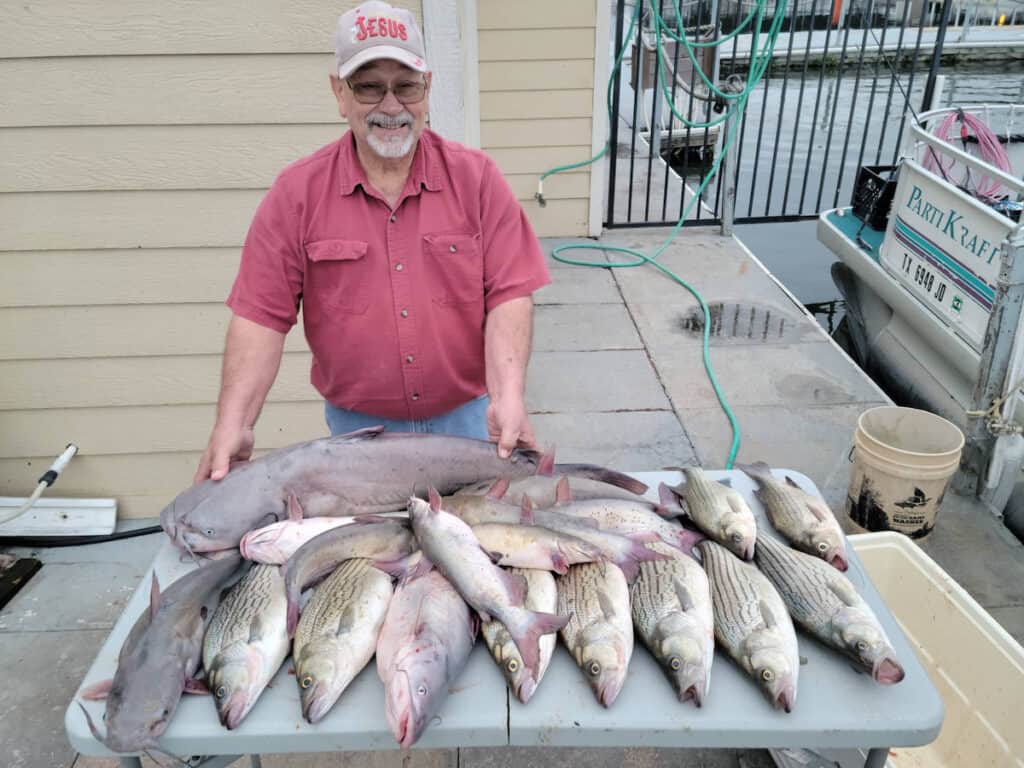
Lake Conroe is a hugely popular recreation lake, not only for fishing but also for pleasure boating and watersports.
It can get very crowded on weekends, and anglers should especially avoid major holiday weekends if they want to beat the crowds.
The lower end of the lake tends to be the busiest, while the upper end is less frequented by speedboats and personal watercraft, making it great for anglers. You’ll need to watch for other hazards, though.
The upper end of Lake Conroe includes vast areas of stumps and standing timber, especially in the backs of coves and on either side of the upper river and creek channels.
A lot of that timber is hidden just inches below the surface when the lake is at a typical level.

